Articles
- Page Path
- HOME > J Musculoskelet Trauma > Volume 33(2); 2020 > Article
- Case Report Treatment of Atypical Ulnar Fracture Associated with Bisphosphonate Therapy - A Case Report -
- Dong-Soo Kim, Ji-Kang Park, Eui-Sung Choi, Ho-Seung Jeong, Seok-Hyun Hong, Byung-Hyun Ahn
-
Journal of Musculoskeletal Trauma 2020;33(2):101-104.
DOI: https://doi.org/10.12671/jkfs.2020.33.2.101
Published online: April 30, 2020

- 277 Views
- 1 Download
- 0 Crossref
- 0 Scopus
Abstract
Bisphosphonates can cause atypical fractures when taken for a long time. Atypical fractures appear mainly as femoral subtrochanteric or shaft fractures. On the other hand, reports of atypical fractures in the proximal ulna are relatively rare, with a high proportion of nonunion cases. This paper reports a case of nonunion after fixation for atypical fractures of the proximal ulna.
Published online Apr 28, 2020.
https://doi.org/10.12671/jkfs.2020.33.2.101
Treatment of Atypical Ulnar Fracture Associated with Bisphosphonate Therapy: A Case Report
 , M.D.,
Ji-Kang Park
, M.D.,
Ji-Kang Park , M.D., Ph.D.,
Eui-Sung Choi
, M.D., Ph.D.,
Eui-Sung Choi , M.D., Ph.D.,
Ho-Seung Jeong
, M.D., Ph.D.,
Ho-Seung Jeong , M.D.,
Seok-Hyun Hong
, M.D.,
Seok-Hyun Hong , M.D.
and Byung-Hyun Ahn
, M.D.
and Byung-Hyun Ahn , M.D.
, M.D.
Abstract
Bisphosphonates can cause atypical fractures when taken for a long time. Atypical fractures appear mainly as femoral subtrochanteric or shaft fractures. On the other hand, reports of atypical fractures in the proximal ulna are relatively rare, with a high proportion of nonunion cases. This paper reports a case of nonunion after fixation for atypical fractures of the proximal ulna.
Fig. 1
Initial anteroposterior (A) and lateral (B) radiographs show a transverse fracture of the right proximal ulna with cortical thickening and marginal sclerosis.
Fig. 2
After 3 months, there was no evidence of union, but metal breakage of the plate had occurred.
Fig. 3
Anteroposterior (A) and lateral (B) radiographs after the second operation.
Fig. 4
Nine months after the second operation, radiological nonunion and implant loosening was observed.
Fig. 5
The operation was performed with an olecranon plate and forearm plate.
Fig. 6
Radiographs 1 year and 10 months after surgery show maintained bone union.
Financial support:None.
Conflict of interests:None.
References
-
Niéto H, Billaud A, Rochet S, et al. Proximal ulnar fractures in adults: a review of 163 cases. Injury 2015;46 Suppl 1:S18–S23.
-

 E-submission
E-submission KOTA
KOTA
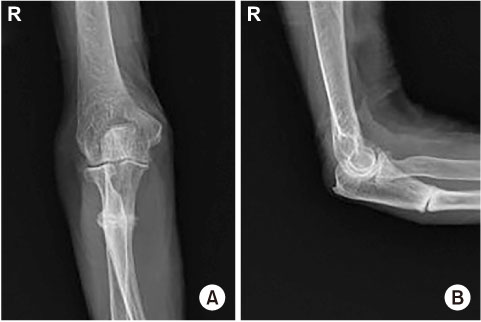
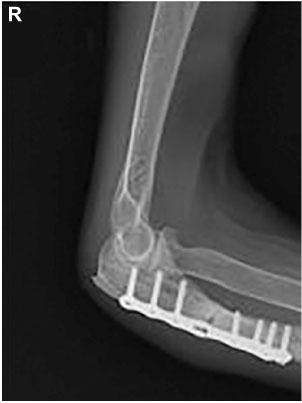

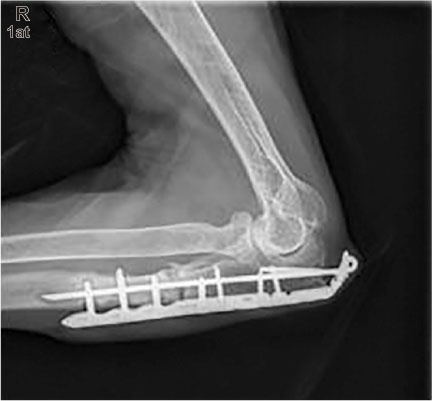
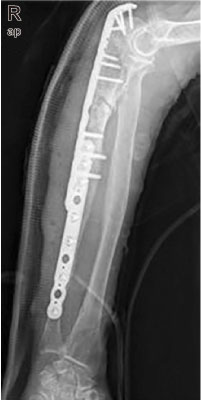
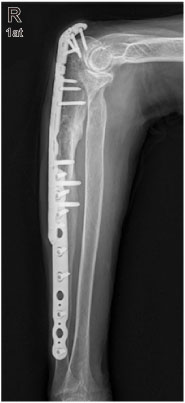

 Cite
Cite

